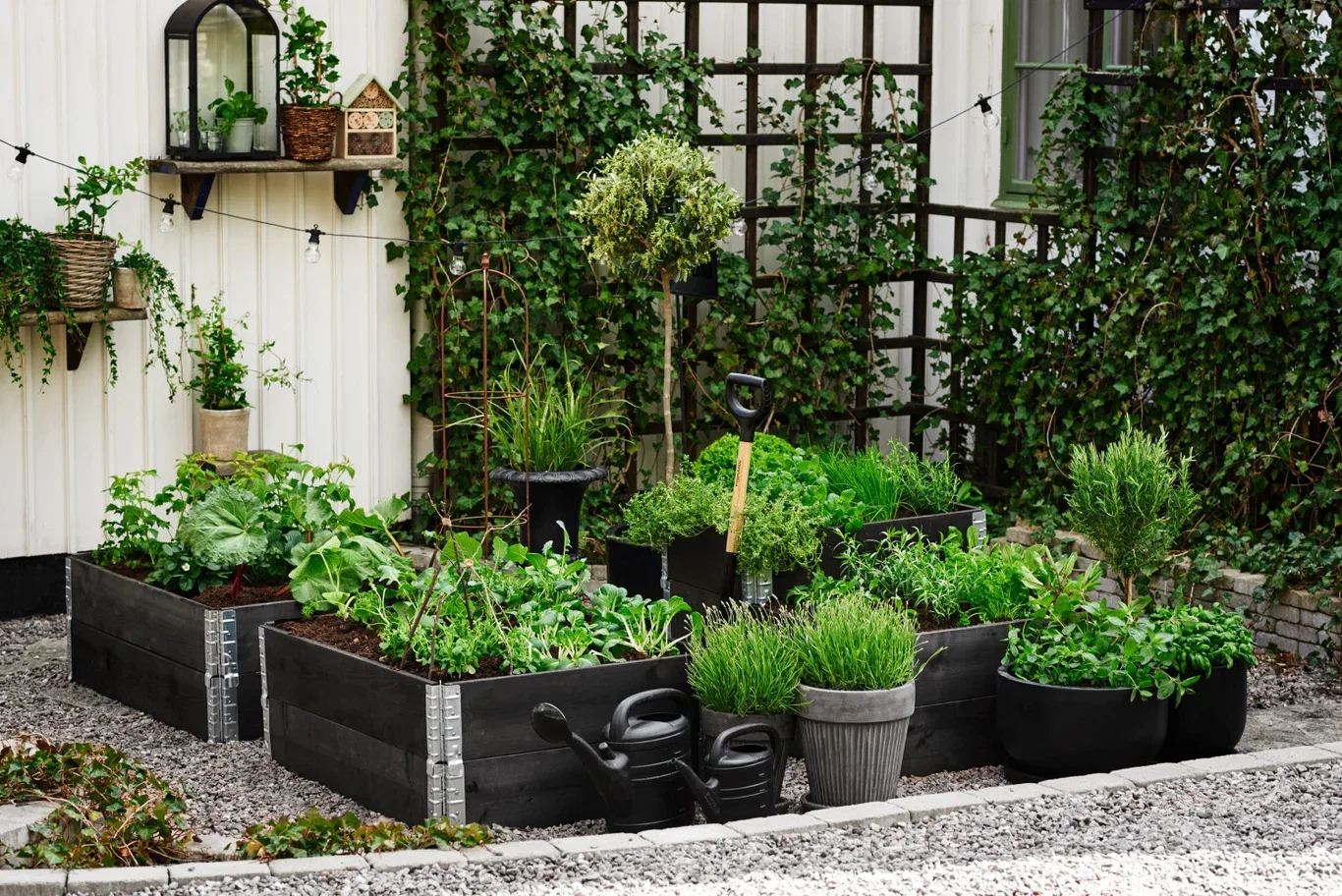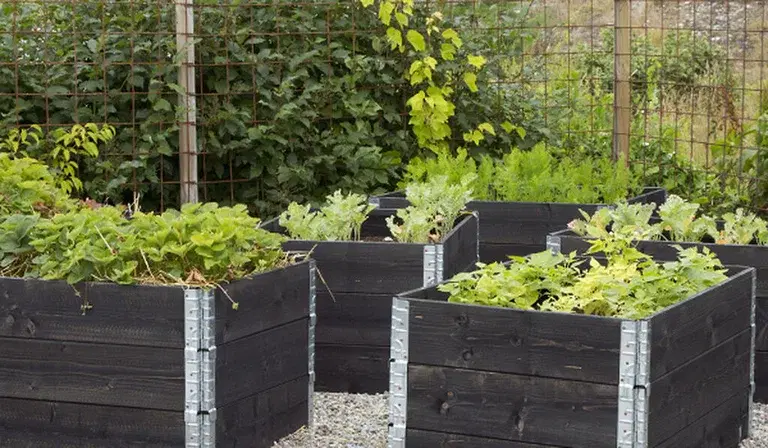Grow in a planting box
Whether you have a tiny balcony or a large garden, it's easy to succeed with planting boxes. We show you how to grow your own vegetables, herbs, and berries – simply and low-maintenance.

How to succeed with planting boxes
A planting box (also called a "pallet box") is a stackable frame available in two different sizes. You choose the height based on what you want to grow and the working height you prefer. For lettuce and other plants with small roots, a simple box will suffice. For plants with a deeper root system, such as potatoes, you will need two or three layers.
By starting with growing in planting boxes, you gain knowledge and experience, which will allow you to expand to a larger kitchen garden or greenhouse later on. The planting boxes are also easy to maintain. You can plant more densely, which reduces space for weeds.
In the garden
- Place the planting boxes in a sunny location, preferably near the house. This way, you'll have easy access to your harvest and also create a great focal point.
- Cover the bottom of the planting box with a weed barrier fabric, extending it a bit up the inside of the edge and securing it, or use wet newspapers (without staples) in the bottom.
- A planting box holds about 200 liters of soil. Create a soil mix consisting of half naturally fertilized soil and half manure. If you want, you can cover the bottom with plant debris and leaves.

Space between the boxes
If you have multiple planting boxes in one area, you can choose the material around the boxes based on the style that suits you. Gravel, cobblestones, or grass are good options. Also, remember that it is practical to be able to access the area with a lawnmower or wheelbarrow to make the work easier.
Small space, no obstacle
Yes, you can grow on the balcony! The size is of course limited, but with a small planting box, you'll have room for both cultivation and a small seating area on most balconies. West and east-facing balconies are probably the most ideal, with half the day in the sun and half in the shade. South-facing balconies are best if you want to grow berries, fruits, tomatoes, and cucumbers.
Balconies facing north pose a bit more of a challenge, but lettuce and some cabbage varieties can thrive here too. Cover the bottom of the box with coarse plastic so that water and soil don’t run out (your downstairs neighbor probably won’t appreciate it). Let the plastic go up a bit on the inside and secure it. Then, fill the bottom with two large bags of expanded clay pellets for good drainage. After that, add soil.
Early start
In the planting box, it gets warmer than in the ground. Therefore, you can plant earlier there than in the vegetable garden. Read the instructions on each seed packet, but feel free to start a little earlier in the planting box.
Tips on what to grow
Choose what you actually like, both in terms of type and quantity. There's no point in growing beans if no one in the family likes them. Also, consider how much time and energy you want to spend on gardening. If you start with too big a project, it can take away some of the joy.
- Herbs
Herbs can be used for many things and are easy to grow. They are also beautiful and smell good. If you let some plants flower, you’ll attract butterflies, bees, bumblebees, and other beneficial insects to your garden. For the best flavor, harvest regularly. - Grow vertically
To make the most of the space, it’s smart to mix tall plants with shorter-growing ones. Examples of tall varieties include tomatoes, cucumbers, beans, and sugar snap peas. - Lettuce
Examples of popular lettuce include arugula, spinach, and leaf lettuce. The leaves are harvested continuously throughout the season, giving you fresh and tasty salad. Sow the seeds in batches a couple of weeks apart until August, and you’ll have lettuce well into the fall. Make the soil surface even, create furrows with your hand, and sow—super easy. Decide if you want to sow in rows, circles, or zigzag patterns. Each seed packet will tell you how deep to plant. Lettuce doesn’t require hard pruning since it’s harvested as soon as it emerges. Trim so it doesn’t get too crowded, but let them touch each other. This way, you’ll get good lettuce and nice boxes. - Not just vegetables
Plant boxes are often associated with vegetables, but anything can be grown in a plant box. A flower meadow, berry bushes, rhubarb, apple trees, tulips, and summer flowers. Only your imagination limits what you can grow.
Crop rotation
Take care of the rainwater, as you can provide your plants with sun-warmed water. Plants need a thorough soaking once their growth is well underway. It’s better to water properly once, rather than small doses frequently. About 20-30 liters are required per square meter, but water carefully with a sprinkler, drip hose, or fine spray from the garden hose.
Fertilization
The nutrients from soil in bags last for about 3 weeks. If you've mixed in manure, it will last a little longer. After this, you should fertilize with either chicken manure, your own compost, or organic fertilizer.
Growing in a planting box in the fall
There's no reason not to use the planting boxes in the fall as well.
- August - September
In August-September, you can grow Asian cabbage, radishes, spinach, and winter salad. These grow and develop quickly. The cool temperatures also reduce the number of pests. - September - October
Ramsons, spring onions, and winter salad, but also well-known flowers like bluebells, bush carnations, forget-me-nots, pansies, and daisies can be sown in September and October. The seeds will grow and form a leaf rosette that overwinters. Protect the small plants with leaves or a fleece before the frost arrives. It might be wise to mark the plants so you can find them again when the snow melts. - October - November
Just before the frost arrives, you can sow vegetables like dill, chives, onions (seeds, not sets), carrots, parsnips, parsley root, radishes, and lettuce. Some annual summer flowers can get a head start if sown in the fall, such as cosmos, delphiniums, marigolds, and poppies. Many perennials are also suitable for sowing in the fall. The seeds will overwinter in the soil and will sprout when light and warmth return in the spring. This is nature's own method and works especially well for seeds that tolerate cold or need cold treatment (stratification) to grow. In October and November, it's also time to plant garlic that will be harvested next year.
If you choose to let the beds rest over the winter, it’s wise to cover them with leaves, straw, or other plant waste. The soil will improve next season with new bags of fertilizer or compost.
Read more:
You are here:














